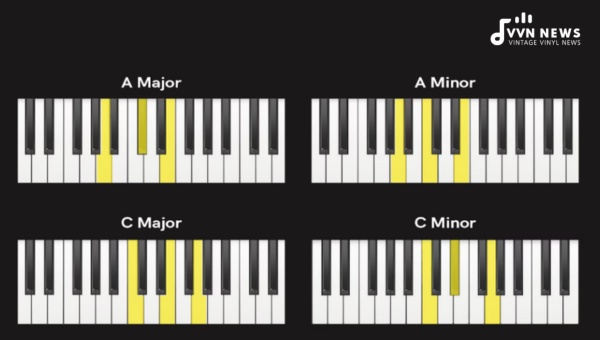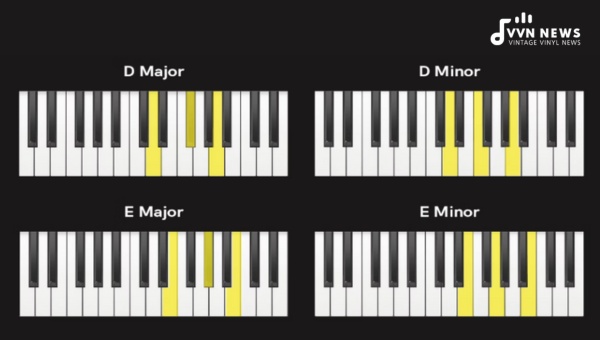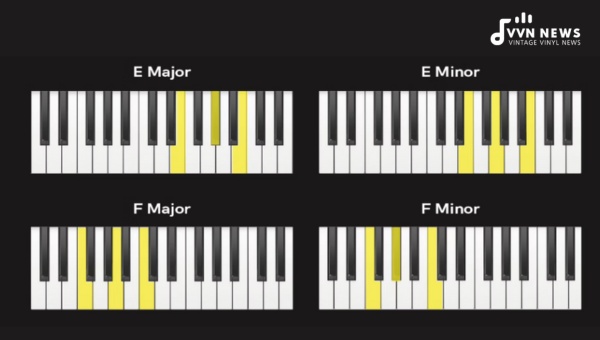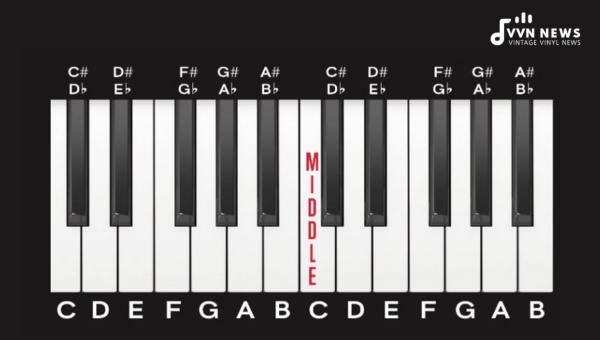Starting your journey into the realm of piano chords can feel like standing at the foot of a giant mountain, wonderstruck by the vast, uncharted territory ahead.
It’s a beautiful yet intimidating world, brimming with different types and sounds, exuding a charm that sets them apart in the world of music. With so many chords, you might be wondering where to start.
Don’t worry; this guide is tailored to help ease you into understanding and playing piano chords with simplicity.
Just as one doesn’t start climbing that colossal mountain without some prep work – getting familiar with the terrain or building up physical endurance – mastering piano chords too requires some groundwork.
It means gaining a basic understanding of what these chords really are and how they form an essential part of any form, genre, or era of music.
Kick-starting your proficiency doesn’t have to be tough; it’s all about gearing up one step at a time.
What Are Piano Chords?
Piano chords are combinations of three or more notes played simultaneously, creating a specific sound and harmony.
They are the building blocks of music and serve as the foundation for melodies and compositions. Piano chords consist of intervals, which are the distances between the notes.
A major chord, denoted by the symbol C or CM, is a group of notes comprising the first, third, and fifth degrees of a major scale.
In the key of C major, a C major chord would consist of the notes C, E, and G. Minor chords, denoted by the symbol Cm, are similar to major chords but with a lowered or flatted third note.
A C minor chord would consist of the notes C, E♭, and G. Other types of chords include augmented chords, diminished chords, and seventh chords, which add complexity and richness to your piano playing.
By understanding and mastering different types of chords, you can unlock a world of possibilities and creativity on the piano.
Parts Of Piano Chords
To truly understand piano chords, it is essential to break them down into their individual components. Let’s explore the different parts of piano chords:
- Root Note: The root note of a chord is the note from which the chord is built. It provides the foundation and determines the name of the chord. For example, in a C major chord, C is the root note.
- Third: The third note in a chord determines whether it is major or minor. In a major chord, the third note is two whole steps above the root note, while in a minor chord, it is one and a half steps above.
- Fifth: The fifth note helps to create the characteristic sound of the chord. It adds depth and stability to the overall harmony.
- Inversions: Inversions are different ways of arranging the notes within a chord. They can change the overall sound and shape of a chord without altering its fundamental structure.
- Extensions: Chords can be extended by adding additional notes beyond the basic triad (root, third, and fifth). Common extensions include seventh chords (adding the seventh note), ninth chords (adding the ninth note), and so on.
Understanding these various components of piano chords will allow you to grasp their structure and sound more confidently when playing them on your instrument.
Also Read: Best Piano Players In The World [Melodies That Have Moved Millions]
How to Play Major Chords on the Piano?

Playing major chords on the piano is a fundamental skill for any pianist. These chords are bright, uplifting, and frequently used in a wide range of musical genres. Follow these steps to master playing major chords on the piano:
- Find the Root Note: Identify the root note of the chord you want to play. For example, if you want to play a C major chord, find the note C on the piano keyboard.
- Understand Intervals: Understand that a major chord consists of three notes: the root note, major third, and perfect fifth. In the case of a C major chord, these notes would be C (the root), E (the major third), and G (the perfect fifth).
- Position Your Hand: Place your right hand on the piano keyboard with your thumb (1st finger) on the root note and your index finger (2nd finger) on the major third. In this case, your thumb would rest on C and your index finger on E.
- Add the Perfect Fifth: Continue positioning your hand by adding your middle finger (3rd finger) on G, which represents the perfect fifth of the chord.
- Play All Notes Simultaneously: Press down all three notes (C, E, and G) at once to create a harmonious sound. Ensure that your fingers are curved and relaxed for optimal technique and accuracy.
- Practice Proper Technique: As you play each note in the chord, make sure to use proper technique by striking each key with an even amount of pressure and maintaining correct hand position.
- Experiment with Inversions: Once you feel comfortable playing basic major chords in root position, you can explore different inversions by rearranging the order of notes within each chord structure. This will add variety and richness to your playing.
Remember to take your time and practice each major chord thoroughly. As you become more proficient, you can apply this knowledge to other keys on the piano, allowing you to play major chords confidently and effortlessly.
Also Read: Guide Of Piano Chords [Unlock Your Musical Potential Today]
How to Play Minor Chords on the Piano?
Playing minor chords on the piano is a fundamental skill that every beginner should master. A minor chord has a distinct sound that adds depth and emotion to your music. Here’s a step-by-step guide to help you quickly grasp and play minor chords on the piano:
- Know the Structure: A minor chord consists of three notes – the root note, the flatted third, and the fifth. For example, in a C minor chord, you would play C as the root note, E♭ as the flatted third, and G as the fifth.
- Find the Root Note: Locate the root note on your keyboard. It is usually situated towards the left side of your piano.
- Lower the Third: To create a minor chord, lower or flatter the third note of the major chord by one half-step (moving one key to the left). In our example of a C major chord becoming a C minor chord, E would become E♭.
- Play all Three Notes Simultaneously: Using your right hand, position your fingers over all three notes – root, flatted third, and fifth – and press them down simultaneously with moderate pressure.
- Experiment with Different Inversions: Inversions provide different voicings for chords by changing their order or arrangement. Try playing around with different inversions of minor chords to discover unique sounds and progressions.
- Practice Smooth Transitions: Work on transitioning smoothly between different minor chords by lifting your fingers off one chord while simultaneously placing them onto another.
By following these steps and practicing regularly, you’ll become more comfortable with playing minor chords on the piano and develop a strong foundation for more complex musical compositions.
What Are Inversions in Piano Chords?

Inversions are alternative ways of arranging the notes within a chord. They allow for greater flexibility and versatility in playing chords on the piano, adding richness and variation to your music. When a chord is inverted, its notes are rearranged so that a different note serves as the lowest or bass note of the chord. This change in voicing can significantly alter the overall sound and character of the chord.
Let’s take a closer look at how inversions work:
- Root Position: The root position is when the root note (the note from which the chord is built) is in the bass or lowest position of the chord. This is the most basic form of a chord, typically written without any additional markings.
- First Inversion: To create the first inversion, you take the root note and move it up an octave, making it the highest note of the chord. The third note becomes the new bass note, resulting in a different voicing and a unique sound.
- Second Inversion: In second inversion, both the root note and third note are moved up an octave, leaving only the fifth (typically called “the pedal”) as the new bass note. This inversion often creates a more dramatic and open sound.
- Third Inversion: Third inversion involves moving all three notes up an octave, so that neither of them lies within an octave below another one; this results in an even more open and spacious sound.
By understanding inversions, you can explore different possibilities for playing chords on the piano, creating smoother voice leading and adding variety to your music.
Experiment with these inversions to achieve different sounds and textures while playing chords.
Also Read: Grand Staff Basics [The Key To Reading Piano Music Notation]
What Is a Piano Chord Chart?
A piano chord chart is a visual representation of various chords on the piano keyboard. It displays the notes that make up each chord, allowing you to easily find and play them. The chart is typically organized in a grid format with the root note of the chord at the leftmost column and different chord types listed across the top row.
Piano Major Chords
In a major chord chart, you will find a list of all major chords, denoted by their root note such as:
- C Major – C, E, G
- C# Major – C#, E#, G#
- D Major- D, F#, A
- Eb Major – Eb, G, Bb
- E Major – E, G#, B
- F Major – F, A, C
- F# Major – F#, A#, C#
- G Major – G, B, D
- Ab Major – Ab, C, Eb
- A Major – A, C#, E
- Bb Major – Bb, D, F
- B major – B, D#, F#
Piano Minor Chords
In a minor chord chart, you will find a list of all minor chords, also denoted by their root note as:
C Minor – C, Eb, G
C# Minor – C#, E, G#
D Minor – D, F, A
Eb Minor – Eb, Gb, Bb
E Minor – E, G, B
F Minor – F, Ab, C
F# Minor – F#, A, C#
G Minor – G, Bb, D
Ab Minor – Ab, Cb, Eb
A Minor – A, C, E
Bb Minor – Bb, Db, F
B Minor – B, D, F#
Using a piano chord chart can be incredibly helpful for beginners as it allows them to visualize different chords and understand their structure without needing to memorize every individual note combination.
It acts as a valuable tool in expanding your chord vocabulary and enhancing your overall piano playing skills.
What Are Common Piano Chord Progressions for Beginners?

As a beginner pianist, mastering common chord progressions is a great way to enhance your playing and start creating music or playing along with your favorite songs. Chord progressions are a series of chords played in a certain sequence that create a musical structure. They provide the foundation for melodies and can evoke different emotions depending on their arrangement. Here are some commonly used piano chord progressions that beginners can start practicing:
- I-IV-V: This progression is one of the most basic and widely used chord progressions in music. In the key of C major, it would consist of the chords C, F, and G. Practicing this progression will help you develop muscle memory and gain familiarity with different chords on the keyboard.
- I-V-VI-IV: Also known as the “Four Chord Song” progression, this sequence has been used in countless popular songs across various genres. In C major, it would consist of the chords C, G, Am, and F.
- I-IV-V7: Adding a seventh chord to the I-IV-V progression gives it a bluesy or jazzy feel. In the key of C major, it would consist of the chords C, F, and G7.
- VI-IV-I-V: This progression is commonly found in ballads and pop songs and offers an emotional and satisfying sound. In C major, it would consist of the chords Am, F, C, and G.
- I-III-IV-V: This progression provides a unique sound by incorporating the third note into the mix. In C major, it consists of the chords C, E minor (Em), F, and G.
These common piano chord progressions will not only improve your finger coordination but also help you understand how different chords work together in a musical context.
Experiment with these progressions and try incorporating them into your own compositions or favorite songs for a more dynamic playing experience.
Also Read: B Flat Minor Chords [Complete Guide And Variants For Piano]
How Are Chords on Piano Notated in Music?
In music notation, piano chords are represented using various symbols and notations. These notations provide valuable information regarding the root note, quality, and structure of the chord. Let’s explore some commonly used chord notations:
- Roman Numeral Chord Symbols: Instead of using letter names to represent chords, Roman numeral chord symbols are often utilized to denote chords within a key. The Roman numerals indicate the degree of the scale from which the chord is built. For example, in the key of C major, a C major chord would be denoted by the symbol I (the first degree), while a D minor chord would be represented by the symbol ii (the second degree). This system allows for easy transposition between keys.
- Diminished Chords: Diminished chords are labeled with a small circle (∅) or with “dim” for diminished. These chords have a unique quality that creates tension and dissonance in music.
- Root Note Labelled and Quality: In sheet music or lead sheets, each chord is typically written with its root note labeled and its quality indicated through abbreviations such as ‘maj’ for major or ‘min’ for minor. For example, a C major chord may be written as “Cmaj,” while a G minor chord may be written as “Gmin.”
- Written Out with Notes: In some cases, especially when playing more complex chords or voicings, piano chords can also be notated by writing out all the individual notes that make up the chord. This provides specific instructions on which keys should be played simultaneously to form the desired harmony.
By familiarizing yourself with these notations and symbols, you can quickly decipher and understand piano chords when reading sheet music or lead sheets. It is essential to practice recognizing these notations to become fluent in playing various chords on the piano.
How to Turn Minor Chords into Major Chords and Vice Versa on Piano

Sometimes, as a pianist, you may encounter a situation where you want to change a minor chord into a major chord or vice versa. This can add variety and complexity to your playing, allowing you to create unique musical expressions. But how exactly can you achieve this transformation? Let’s explore the step-by-step process:
Changing Minor Chords into Major Chords
- Identify the Minor Chord: The first step is to identify the minor chord that you want to change into a major chord. For example, let’s take the C minor chord (Cm).
- Raise the Third Note: In a minor chord, the third note is lowered by a half step from its major counterpart. To turn a C minor chord (C-E♭-G) into a major chord, raise the third note (E♭) by half a step, transforming it into E.
- Adjust Other Notes: Once you have raised the third note, leave the other notes of the chord unchanged – C and G in this case.
- Play the Major Chord: After making these adjustments, you will have transformed Cm into C major (C-E-G). Play all three notes simultaneously to hear the new sound of your major-chord creation.
Changing Major Chords into Minor Chords
- Identify the Major Chord: Start by identifying the major chord that you want to change into a minor chord. Let’s use C major (C-E-G) as an example.
- Lower the Third Note: In a major chord, lower its third note by one half-step to create its minor equivalent.
- Keep Other Notes Unchanged: Leave all other notes of the original major chord untouched – C and G in this case.
- Play the Minor Chord: When you play C major (C-E-G) and lower the E note to E♭, you’ve successfully transformed it into C minor (C-E♭-G).
By following these steps, you can easily convert between major and minor chords on the piano, adding versatility to your playing. Experiment with different chord progressions and explore the distinct emotions that major and minor chords evoke. With practice, you’ll gain confidence in transforming chords and create unique musical experiences.
What Is Ear Training for Chords on Piano?
Ear training is a crucial skill for any pianist, as it helps develop your ability to hear and identify chords by ear without the need for sheet music or written notation. It allows you to play chords intuitively and improvise more freely. Here are some key points to understand about ear training for chords on the piano:
- Developing Relative Pitch: Ear training helps you develop relative pitch, which is the ability to identify and recreate musical intervals and chord relationships. This skill allows you to recognize the difference between major and minor chords, as well as other chord qualities.
- Sing and Play: To improve your ear training skills, practice singing along with piano chords while playing them on your instrument. This exercise helps you internalize the sound of each chord and reinforces their unique characteristics.
- Interval Recognition: Train your ears to recognize different intervals within a chord structure. Start by identifying simple intervals like major thirds or perfect fifths, then progress to more complex intervals found in extended or altered chords.
- Chord Progression Recognition: Practice recognizing common chord progressions by ear. This involves listening to a sequence of chords and identifying their harmonic relationship, such as I-IV-V in a major key or ii-V-I in jazz music.
- Transcribe Songs: Transcribing songs by ear is an excellent way to develop your chord ear training skills. Listen closely to the chords being played in a song and try to reproduce them on your piano without looking at sheet music.
- Use Ear Training Apps or Software: There are numerous ear training apps and software available that can help you practice identifying chords by ear. These programs often provide exercises specifically tailored for piano players.
Consistent practice is key when it comes to improving your ear training skills for piano chords.
By dedicating regular time to train your ears, you’ll become more confident and proficient at identifying chords solely through your auditory perception.
Also Read: 24 Best Chorus Pedals In 2025 [Deliver A Rich & Wide Guitar Sound]
FAQs About Piano Chords
How do I play major chords on the piano?
To play a major chord on the piano, start with the root note, skip a key, then play the next two keys together. For example, to play a C major chord, press C, skip D, and press E and G together.
How do I play minor chords on the piano?
To play a minor chord on the piano, start with the root note, skip a key, then press the next two keys together. For example, to play a C minor chord, press C, skip D♭ (D flat), and press E♭ (E flat) and G together.
What are inversions in piano chords?
Inversions are different ways of arranging the notes within a chord. They help create alternative voicings and can add variety and texture to your music.
What is a piano chord chart?
A piano chord chart is a visual representation of various chords on the keyboard. It shows you where to place your fingers to play specific chords and serves as a helpful reference tool.
What are common piano chord progressions for beginners?
Some common beginner-friendly chord progressions include C-F-G (I-IV-V), Dm-G-C (ii-V-I), and Am-F-C-G (vi-IV-I-V). These progressions show up in many popular songs and provide a solid foundation for playing different musical genres.
Conclusion
Piano chords are an essential element of playing the piano that adds depth and harmony to your music.
By understanding the structure of chords, including their root note, third, and fifth, you can begin exploring a wide variety of sounds and creating captivating melodies.
The ability to play different chord types, such as major and minor chords, inversions, and extensions, will expand your musical repertoire and allow you to express yourself creatively on the piano.
So start practicing those chords and let the beautiful sounds fill the air.








